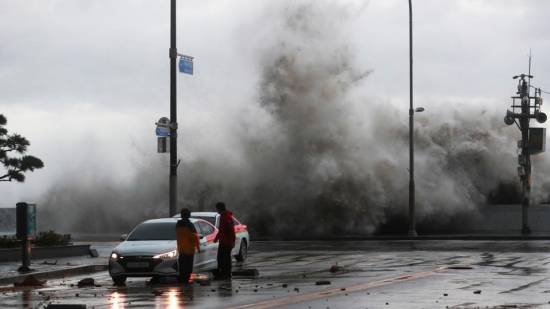Typhoon Hinnamnor batters South Korea, leaves southwest Japan without power Featured
The most powerful typhoon to hit South Korea in years has battered its southern region, dumping almost a metre of rain, destroying roads and felling power lines, leaving 20,000 homes without electricity as thousands of people fled to safer ground.
Typhoon Hinnamnor on Tuesday grazed the resort island of Jeju and made landfall near the mainland port of Busan in the morning and was moving northeast toward the sea with winds of up to 144 kilometres per hour. It is on track to move closer to eastern China later in the week, after ferry services in eastern China and flights in Japan were suspended in previous days.
South Korean officials put the nation on alert about potential damages from flooding, landslides and tidal waves unleashed by Hinnamnor, which came just weeks after heavy rains in the region around the capital Seoul caused flooding that killed at least 14 people.
Prime Minister Han Duk-soo called for evacuations in areas vulnerable to flooding, saying Hinnamnor could end up being a “historically strong typhoon that we never experienced before.”
The storm dumped more than 94 centimetres of rain in central Jeju since Sunday, where winds peaked at 155 kph.
A 25-year-old man was missing after falling into a rain-swollen stream in the southern city of Ulsan, according to the Ministry of the Interior and Safety, which didn’t immediately report more casualties.
The Safety Ministry said more than 3,400 people in the southern regions were forced to evacuate from their homes because of safety concerns and that officials were advising or ordering 14,000 more people to evacuate. At least five homes and buildings were flooded or destroyed, and scores of roads were damaged.
Workers as of 6 am managed to restore electricity to 2,795 of the 20,334 households that were knocked out of power.
In North Korea, state media reported “all-out efforts” to minimise damage from flooding and landslides.
The Korean Central News Agency reported leader Kim Jong-un during government meetings had issued unspecified “detailed tasks” to improve the country’s disaster response capacity but it didn’t elaborate on the plans.
North Korea sustained serious damage from heavy rains and floods in 2020 that destroyed buildings, roads and crops, shocking the country's already-crippled economy.
Hinnamnor heads towards Japan.
On Tuesday morning, the typhoon was over the Sea of Japan, known as the East Sea in Korea, 100 kilometres off Tsushima island of Nagasaki prefecture in southwestern Japan, according to the Japan Meteorological Agency.
More than 35,000 households were without power in Japan's southwestern Kyushu region, Kyushu Electricity said in a statement.
Packing gusts of up to 180 kilometres per hour, it was moving northeast at a speed of 45 kph and was expected to bring heavy rains to western Japan on Tuesday.
Some of Japan's famed bullet trains were suspended due to strong winds and rain, and many local trains also paused service, operator JR Kyushu said.
At least 120 flights departing and landing at Kyushu's airport were cancelled, public broadcaster NHK reported.
Source: agencies


